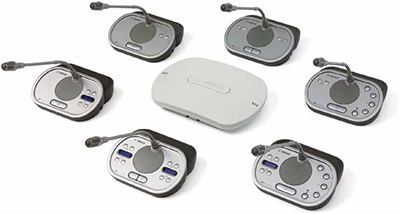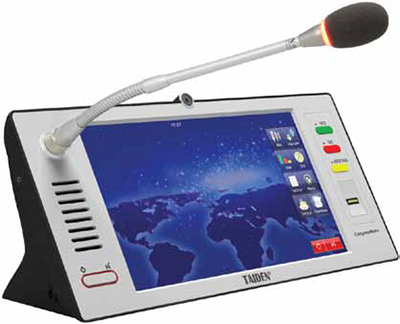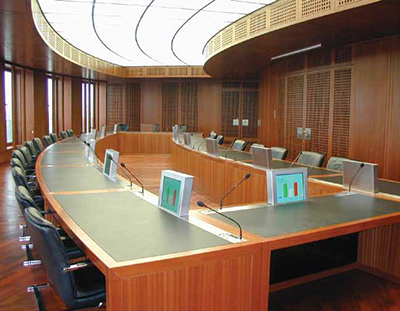Microphone conference systems can play an important role in facilitating effective groupthink, an area of AV where client
expectations continue to expand.Be heard! Even as AV installations become increasingly ambitious, manufacturers and integrators are continuing to stay focused on the fundamentals. When planning an environment where communication is a high priority, microphone conference systems remain essential for participants who need to speak, hear, and be understood— no matter what the conditions.
When applied correctly, microphone conference systems can play an important role in facilitating effective groupthink, yet another area of AV where client expectations continue to expand. “One way the perfect meeting is evolving is by the need for many different meeting configurations,” noted Brooks Gibbs, conferencing product group leader for Listen Technologies, a provider of diverse sound solutions. “Sometimes it’s over a lunch with round tables with interaction encouraged, sometimes it’s a panel and an audience listening, and sometimes it’s around a table and very formal. However, the perfect meetings tend to encourage and welcome interaction and collaboration between the participants.
“This makes it critical to have a communications system that provides flexibility,” Gibbs continued, “and yet allows participants the opportunity to hear and be heard, and to come to consensus on the items being addressed so business can move forward.”
According to Mark Andersen, product marketing manager of Bosch’s public address systems division, conference microphone systems are uniquely qualified to address the new requirements of today’s plugged-in meetings. “Locating a microphone, headphone jack, and speaker in each delegate unit eliminates most of the room acoustic challenges,” he noted. “Individual headsets with volume control can improve intelligibility for listeners as well. New HD cameras controlled by the conferencing system can record higher quality images and provide a clear record of the proceedings, and they also provide a better audience experience when the proceedings are projected or broadcast at a later date. As well, mixing wired and wireless systems allows for easy room coupling, audience participation, and multi-session applications.”

Bosch DCN wireless conferencing desktop consoles offer versatility, high audio quality, and data transmission while providing complete control over conference proceedings.As integrators plan the implementation of microphone conference systems, transparency, ease of use, and system dependability are all attributes that should be at the forefront of their decision-making. “Clients just want to have a productive and engaging meeting and not worry about the technology,” said Gibbs. “All too often those of us in the AV industry want to sell technology and we’re not great at selling an experience—the client wants an experience. What’s great about conference microphones is that they enhance the meeting with no wires or only one cable. It’s easy to see who is talking, who wants to talk and most importantly, everyone can be heard through the speaker in each unit.”
Although the ability of microphone conference systems to run smoothly in the background may be paramount, manufacturers nonetheless remain committed to moving these tools forward in keeping with their customers’ needs—a task that’s easier said than done. “The realities of the market place are ever-changing,” acknowledged David Astri, managing director of Conference Systems, a longtime provider of conference technology. “As soon as a product is brought to market, there will always be something you wished was included. It is almost guaranteed that a new product will be greeted with ‘Why didn’t you?’ rather than ‘I’m really glad you...’”

The Taiden HCS-8300 Series Paperless Multi-Media Congress
System is designed for high-end meetings such as summits,
congresses, parliaments, and city councils. It is equipped with
a 7-inch by 10-inch high-resolution LCD touch panel and
integrated three-megapixel camera.To keep ahead of the curve in this space, therefore, innovations may come across more subtly than in other sectors of AV . For Conference Systems, the appeal of its new Digimic CMic CSV tabletop delegate microphone unit lies in a user-friendly interface that accommodates “push-to-talk” and “request-to-speak” functions, an OL ED display, and five keys for channel selection or voting. Selectable voice activation or push-to-talk modes are available, while two integrated loudspeakers provide balanced decentralized voice amplification to improve speech intelligibility—particularly useful in conference areas without a PA system. Each CMic CSV is also equipped with an amplified headphone socket and corresponding volume control.
Streamlining—not simply enabling—wireless and recording capabilities is also increasingly important. “Our newest wireless conferencing system is literally plug-and-play,” said Listen Technologies’ Gibbs. “It is easy to set up and use with no need to wire anything together. Our system is so easy that a non-technical person could set it up: No central unit, and the only cable is the power cable to the wireless access point.
“In addition to the ease of use,” he continued, “customers require the ability to record meetings for many reasons. Listen systems can provide this feature from simple recording on a US B flash drive attached to a port on the conference unit, to a simple webcasting encoder to allow live streaming and archive recording.”
So where is use of these systems on the rise? Growth sectors cited by Patrick Herlihy, senior product manager of Media Vision USA , include teleconferencing and customers seeking green technology for their meeting spaces. “In larger teleconference spaces that require both voice lift for the far end and amplification of the voice inside the room, standard boundary and ceiling mounted mics do not allow enough gain before feedback,” he said. “Enter the conferencing microphone solution. By bringing the microphone element closer to the person speaking, limiting the number of live microphones, and utilizing the onboard loudspeakers to create a local sound field—thus keeping the overhead speakers at a lower level—we are able to greatly enhance the quality of the audio both in the conference room and on the far site.
“With the movement toward energy saving smart buildings and green technology, the TAI DEN 8300 System offers new opportunities for those that have mandates to go paperless and get additional funding for their projects for doing so,” Herlihy added. “This system can be scaled to act as a simple video monitor per station [confidence monitors], or be built up to full video and document handling capacity, which opens up many new applications and opportunities.”
As growth verticals, Gibbs includes the use of wireless systems by rental AV companies to improve offsite conference and group meetings, multi-purpose training and conference rooms, government agencies needing simultaneous interpretation functionality for multilingual meetings, city halls and school boards, and universities promoting discussion-oriented learning in large lecture halls.
As always, convergence is the watchword for what’s next: Bosch’s Mark Andersen expects a whole other dimension of microphone conference system integration for AV professionals to master.
“One of the most interesting new requirements for these systems blends the use of multimedia with conferencing applications,” he said. “Sharing a presentation, voting, managing remote locations wirelessly, can all be done securely and easily with new systems. As users become more comfortable with their tablet computers, they will look for similar touch screen access and capability in their conferencing systems. Dealers and integrators who are comfortable integrating these systems will find a market growing faster than the traditional conferencing space.”
David Weiss (www.dwords.com) writes extensively about AV, audio, and broadcast technology.
